Three Insanely Easy Chord Structures for Nuanced Melody in the Key of C
You can use some incredibly simply dyadic chords to form more melodic and dynamic melodies.

I’ve found that the full, open C chord guitar form, while perfectly lovely, is not always your best option. It certainly shouldn’t be your only option.
But we tend to “default” to that form without even thinking. Maybe it’s the first chord we learned or maybe it’s just the most comfortable shape and what our fingers are used to finding when we think, “Oh, I need to play a C chord.”
Whatever the reason, getting into the habit of always using it is problematic.
Because a lot of musical situations call for more subtle and nuanced chording, or what some might call a “minimalistic” approach to a chord or melody.
While the open C major can be our home base, we need to branch out into other structures, and we can use some incredibly simply dyadic chords to do so.
Our plan of attack will look something like this:
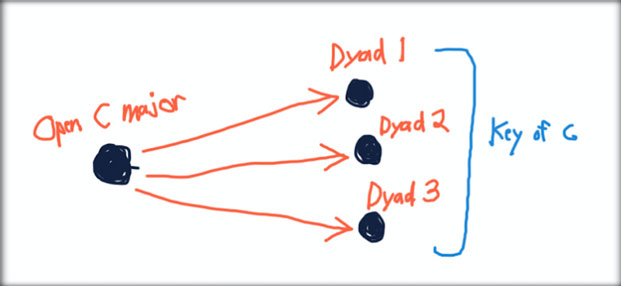
Dyadic Chord Forms
Dyads make excellent chord structures, allowing us to play only two notes or add intervals based on how thick we want our chord to be. All we need is our root (C in this case) and a couple of basic intervals. Here are the three I find to be the most common:
- 1. Root plus an octave
- 2. Root plus a third
- 3. Root plus a fifth
I frequently find myself using these combinations, usually just two at a time. In some cases I’ll group these intervals, coming up with a triadic chord of sorts. For example, I might play the root, plus a fifth and an octave on the higher register, like this:
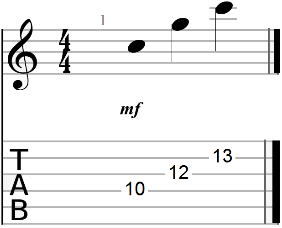
Arpeggiated from left to right you have the root, a fifth and the root’s octave (tonic). Add some delay and reverb to the mix and you get a really chimey, sweet-sounding chord/melody. Moreover, you can continue adding intervals and melody depending on how “noisy” you want to be:

You then have the variance of moving your root note to a new position on the fretboard and the conglomerate of intervals to work with. At this point, you have plenty of options for adding nuanced melody, or you can stick to the simplicity of the dyadic chord shape. Whatever the music calls for.
This is helpful because sometimes it just sounds better to play a more minimal version of the C chord. By habit now, I tend to default to one of these dyadic structures.
Using the Structures
So, here’s the million dollar question: How do we use those intervals to build other C chord structures? If we already know our interval theory, the process is really simple:
1. Find the root
2. Add a third, fifth or octave
3. Improvise a melody
Let’s outline all three dyads for our octave, third and fifth intervals.
Three Common Dyadic Chord Shapes in the Key of C
If we choose a root position for our C chord, which is usually the fifth string at the third fret, we can add an octave by simply moving up two frets to the third string.
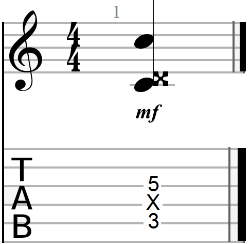
From the same fret position, we can add a third, which is drawn straight out of the full C major open chord shape.
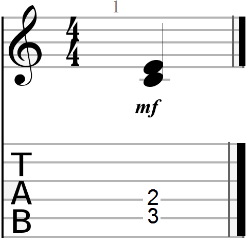
And finally, we add the fifth, just like we did in the first example, though this time we have our root note planted at the third fret.
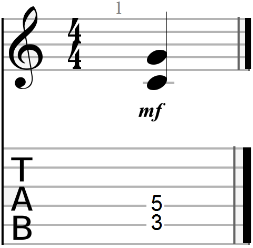
Note that anytime you identify a spot on the fretboard where a C is located, you have the root of your chord and can apply these same dyadic shapes. Being able to build chord structures in the key of C is that easy. If you can find the root, you can immediately migrate to that spot on the fretboard and either use the dyad as-is or add melodic filler at your discretion.
Now, for the melody:
Suppose you want to add some of the filler I just mentioned. You can do it by using a kind of faux, simplified voice leading technique, which ends up being a running melody that exists beneath the root C note.
For example, let’s run a connection between the third and fifth of the root C:
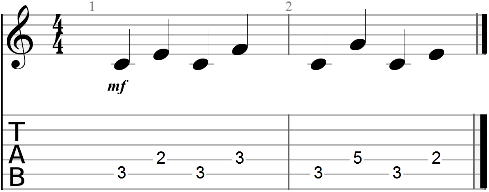
I’ve broken up each dyad into two notes to make the melodic line on the fourth string stand out a little more. Let’s try the same thing with our original example, with the fifth and tonic:
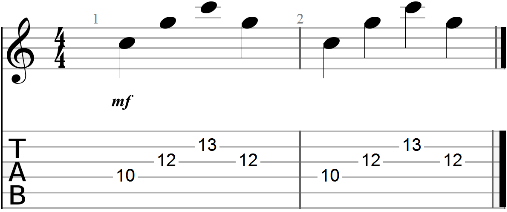
In this tab we’ve simply arpeggiated an arrangement of the root, its tonic and the fifth of the root. This tactic provides some insanely easy ways to improvise over the C chord and can be applied to any musical key, assuming you know where the root notes are on the fretboard. While we’ve used the key of C as our grid, the tactic is universally applicable.
Moreover, it’s an incredibly simple rhythm and lead technique.
The morale of the story: Don’t always just default to the open C major chord. It’s a great chord and all, but the experienced guitarist knows their fretboard notes and can migrate familiar chord forms to turn them into more melodic, dynamic melodies that are fresh to the listener’s ears.
Flickr Commons Image via Kmeron
Robert Kittleberger is the founder and editor of Guitar Chalk. You can get in touch with him here or via Twitter.
Get The Pick Newsletter
All the latest guitar news, interviews, lessons, reviews, deals and more, direct to your inbox!
Bobby is the founder of Guitar Chalk, and responsible for developing most of its content. He has worked with leading guitar industry companies including Sweetwater, Ultimate Guitar, Seymour Duncan, PRS, and many others.








![Joe Bonamassa [left] wears a deep blue suit and polka-dotted shirt and plays his green refin Strat; the late Irish blues legend Rory Gallagher [right] screams and inflicts some punishment on his heavily worn number one Stratocaster.](https://cdn.mos.cms.futurecdn.net/cw28h7UBcTVfTLs7p7eiLe.jpg)


